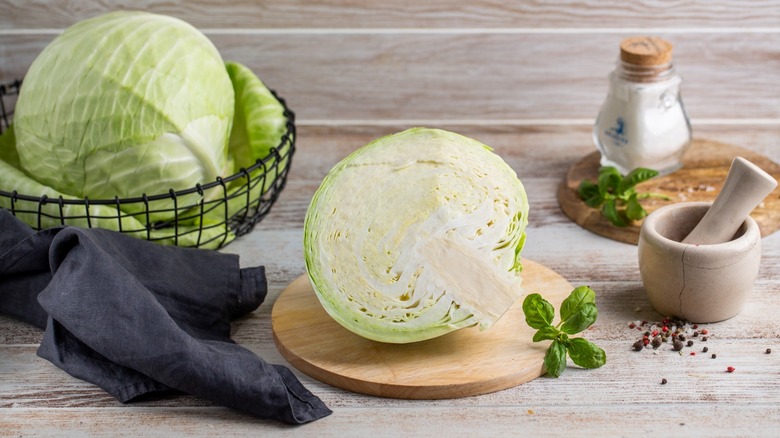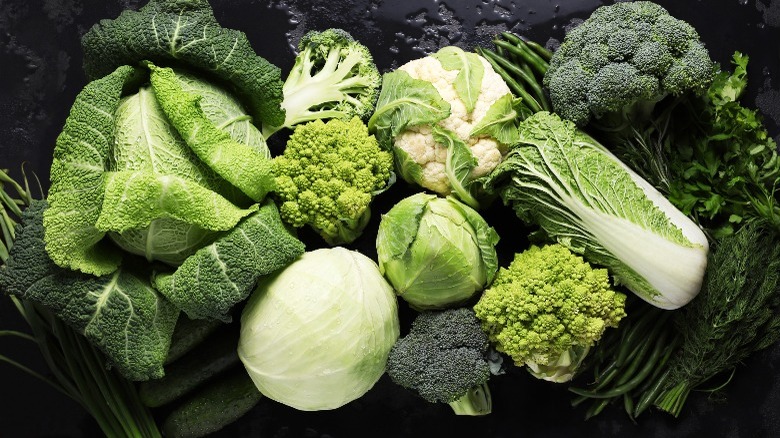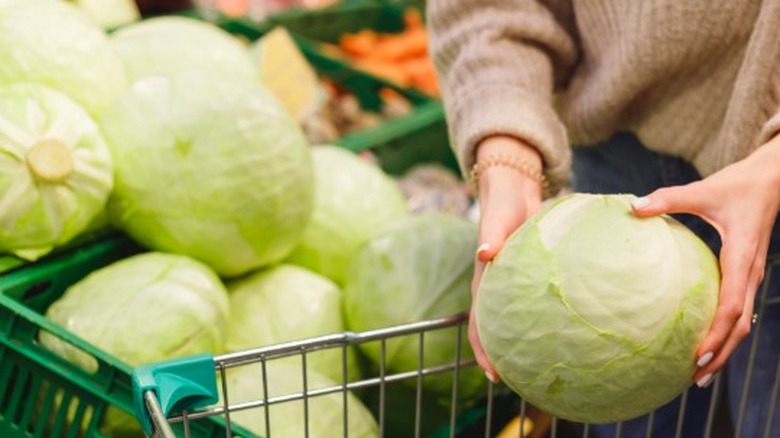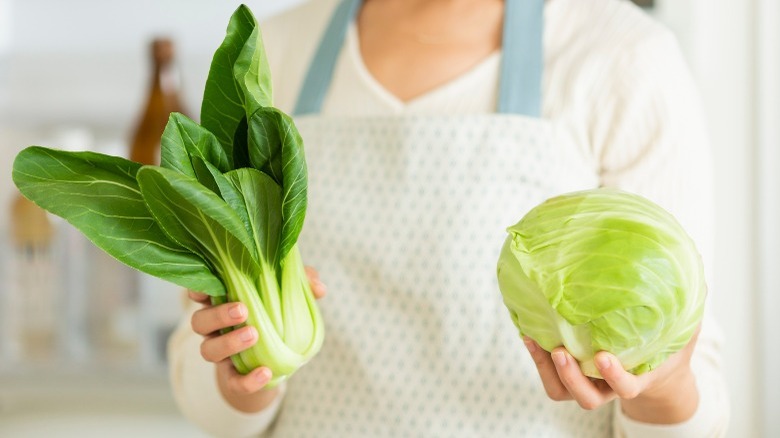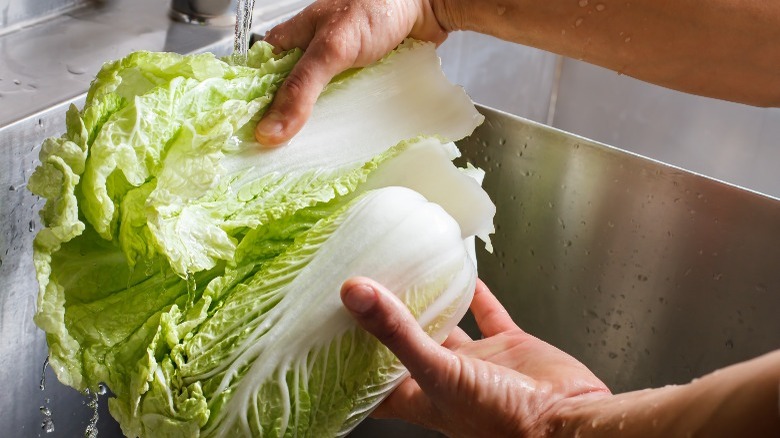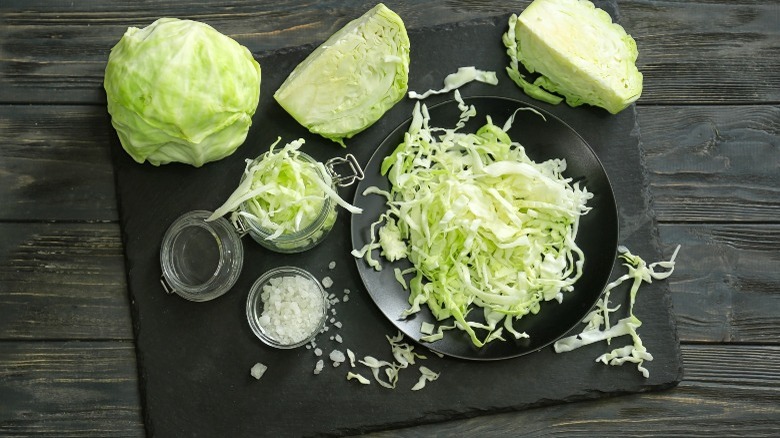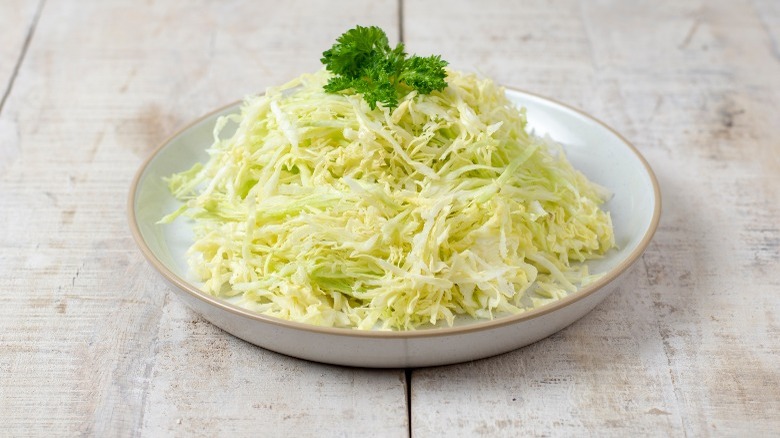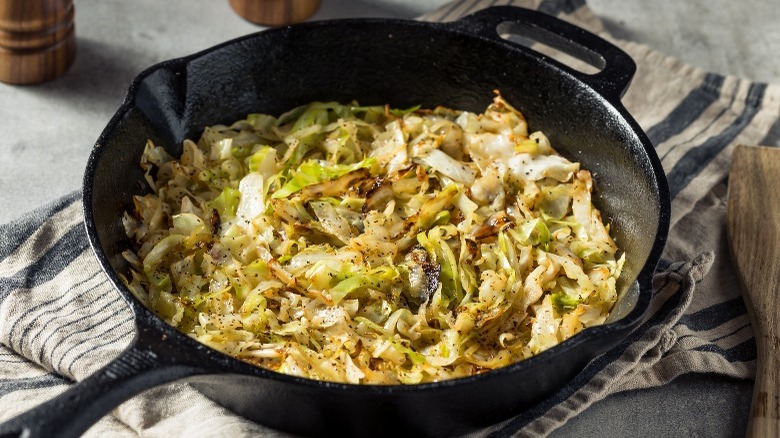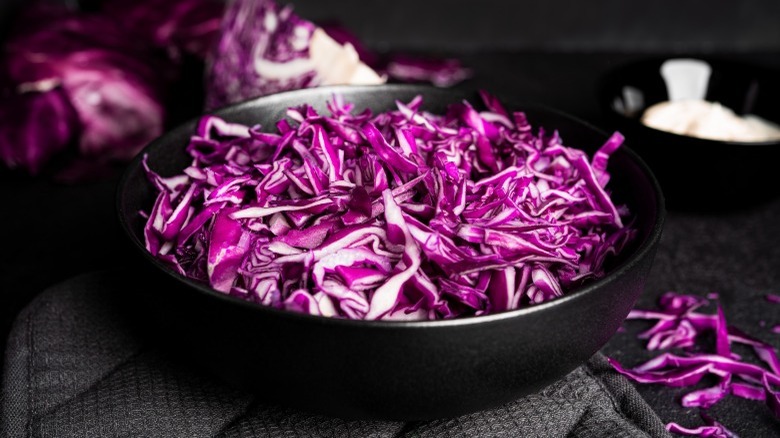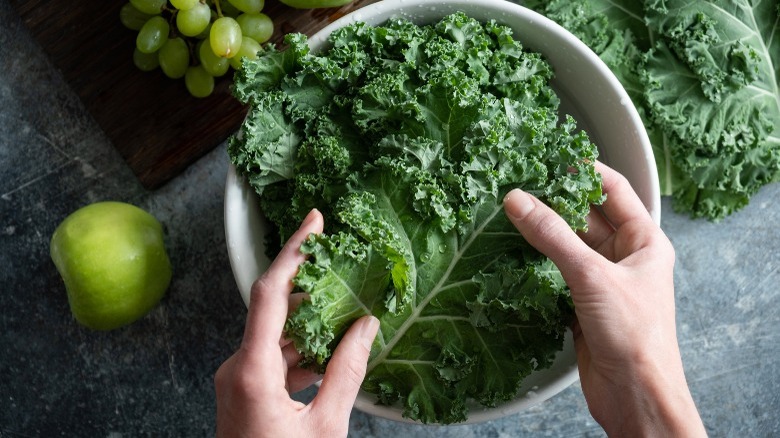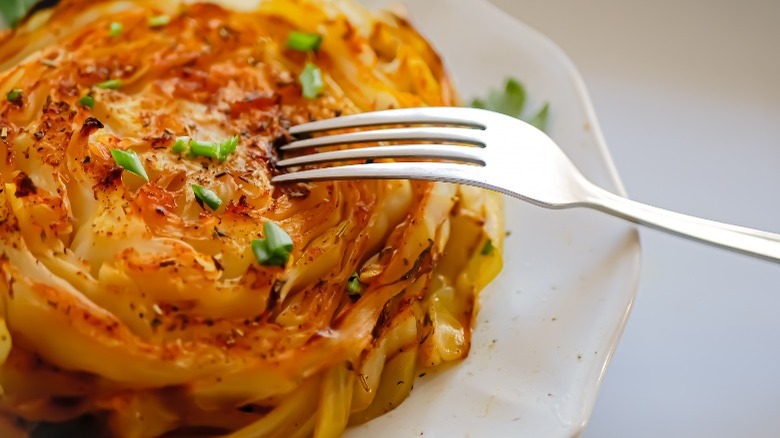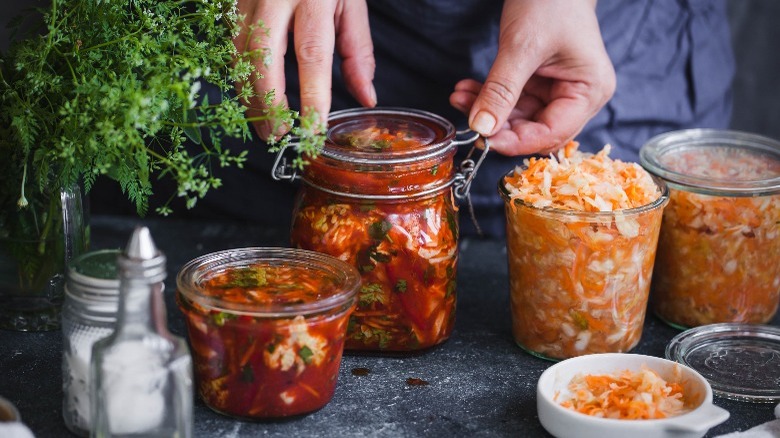12 Tips You Need When Cooking With Cabbage
Whether you're looking for a light and healthy side dish, a hearty entrée, or a flavorful condiment, cabbage can handle it all. It is an incredibly versatile and nutrient-rich vegetable that belongs to the Brassica family. Its wild ancestor is native to the Mediterranean region, but its domestication happened somewhere in Europe, where red and purple varieties were cultivated around the 16th century (via Harvesting History). Due to its resistance to cold weather, cabbage has become an essential vegetable in colder countries and has taken a prominent place in cuisines around the world.
With all that said, cabbage can also be challenging to cook with. It's not always given the respect it deserves because, in the hands of an unacquainted cook, it can turn into an unappetizing, limp, discolored, and –worst of all — terribly smelly mess. Fortunately, you can easily transform your cabbage frustrations into delicious meals with a few tricks. From selecting the right type of cabbage for your needs to prepping and storage recommendations, these tips will help you master the art of cooking with cabbage in no time.
1. Study your cabbage varieties
Before you start cooking with cabbage, it is important to pick the right variety for your recipe. Luckily, there are at least 14 types of cabbage to choose from, ranging from dark green to nearly white, smooth to crinkly, tight-headed to loose-leaved.
The most common type of cabbage in Europe and North America is Brassica oleracea var. capitata L., which is crunchy, sweet, and juicy. Plenty of recipes in these regions' cuisines capitalize on this accessible and durable vegetable. Its closest relatives are kale, broccoli, and cauliflower. Napa cabbage, on the other hand, is more closely related to the turnip, despite the visual similarities to cabbage. Alongside bok choy, it shines in recipes from Asian cuisines.
When it comes to produce, it's important to consider seasonality to maximize nutritional intake. For instance, New Yorkers will be able to enjoy cabbage, kale, and bok choy seasonally only several months a year in the late summer and fall, while Californians can gorge on them year-round, according to Seasonal Food Guide. Fortunately, you could still buy most of them throughout the year, no matter your location.
2. Pick the right head of cabbage
Unsurprisingly, the reason we count cabbage in heads is due to the veggie's uncanny resemblance to a human head, which is reflected in its etymology. The word cabbage actually comes from the old French "caboce." In turn, that word combines "caput," which is Latin for "head," and "boce," which means swelling (via "Cupboard Love 2: A Dictionary of Culinary Curiosities"). So what should you look for in a perfect "swollen head" of cabbage?
When shopping for cabbage, take only the heads that are firm and well-compacted, with no browning or markings that could indicate worm damage. The leaves should be fresh and crisp, and the color of the leaves should match the variety you're buying. Typically, the darker green the leaves are, the more flavor they will have. The stem should be trimmed and look fresh, not dry and cracked. To ensure quality, red and green cabbage should have a solid, tight head and be weighty in comparison to their size.
Savoy cabbage is usually less dense, while napa cabbage typically takes the shape of an oblong head and is more lightweight. Slight wilting or discoloration of any of these cabbages is permissible as long as it's kept to the outer leaves. Try to avoid precut or shredded cabbage, as it loses its vitamin C content quickly, even when wrapped tightly.
3. Create the best cabbage storage conditions
Avoiding common produce storage mistakes can be challenging at times. Fortunately, it's pretty hard to ruin cabbage, for it has a reputation as a durable, low-maintenance vegetable.
It is possible to keep fresh cabbage for up to four months when stored in cellar conditions. That implies temperatures just over freezing (30 f to 36 F) and high humidity. But if you're one of the cellar-less people, a crisper drawer in your fridge will do just fine. To prolong cabbage's fridge storage, you should only rinse it just before consuming it. Additionally, if the cabbage has a lot of outer leaves, keep them on, as this will help protect the inner leaves and ensure they retain their moisture and stay fresh longer. This way, whole cabbage can keep up to two months. However, cut and shredded cabbage is prone to oxidation and vitamin loss, so it's best to keep it tightly wrapped in plastic or an airtight container and use it within a few days.
If you're worried that the storage conditions you created are not optimal, common signs that your cabbage has gone bad include notable softening of its tissues, with discoloration in the form of gray and black streaks. Furthermore, while cabbage is generally known to have an off-putting smell to many, the odor of a rotting head will definitely repel even the biggest cabbage fans. Finally, if the cabbage has a nauseating taste, it can be assumed that it has gone bad.
4. Don't skimp on prep
Prepping cabbage for cooking begins with cleaning it. Although the process is not complicated, it is still essential. While the outer layers act like a shield, which can be discarded to reveal a perfectly clean head inside, it is best to rinse your cabbage thoroughly anyway. For one, even a firm head of cabbage may have bugs inside the folds.
Multiple techniques can make cleaning easy and fast if you want to ensure that your cabbage is safe to eat. Start by removing the outer leaves, which are often damaged or visibly smudged with dirt. Next, soak the cut-up parts in cool water. Finally, to ensure you get rid of all bacteria and critters, add about half a cup of vinegar per cup of water in your produce bath.
Another hands-off prepping technique you might want to remember is using the freezer to separate cabbage leaves. You can freeze an entire rinsed head overnight instead of boiling it — this method will likewise break down the cellular structure, but without the sulfur stink or using extra energy.
5. Slice it up or keep it whole
Initially, a full head of cabbage may appear daunting, and the mere idea of cutting it might tempt you to use preshredded leaves. Don't: not only are those less nutritious and have a shorter shelf life than whole heads but cutting cabbage is easy if one is familiar with the right technique.
After removing the loose outer leaves and rinsing the head with water, place it on a cutting board, stem-side down, then divide the head into quarters. Now, if you're prepping your cabbage for roasting or braising, it is best to leave it as it is, with the core intact. This ensures that it does not break down after being subjected to heat. On the other hand, if you're making coleslaw, remove the cores from the quarters and slice them into thin strips, beginning from the short end opposite the stem. Alternatively, use a mandoline and slide the wedges across its sharp blade.
If you're still hesitant to pick up the knife, we have good news: cooking a whole head of cabbage is an option. For a fuss-free vegan entrée at the holiday table, roast it in the oven or an Instant Pot with dairy-free butter and complementary spices, such as garlic powder and paprika. Alternatively, remove the core and inner leaves and stuff it with mince, cheese, and veggies, for a more filling meal.
6. Use your cabbage scraps
After prepping cabbage, you're inevitably left with tough outer leaves and cores. You likely throw them away or send them down to compost, but that won't be necessary once you learn how to reuse those cabbage scraps.
First of all, the darker outer leaves are generally more nutritious. Considering they receive more light, they produce more pigments and antioxidants to process the energy input, which results in a darker hue. Thus, the inner leaves of cabbages that form tight heads contain less carotene than the outer leaves, according to "On Food and Cooking." Fortunately, there are several ways you can use up outer cabbage leaves and keep those extra bits of nutrition. For instance, they shine in recipes that rely on their sturdiness (like cabbage rolls). You can also cook them down into soups and stews or use salt and acid to make them more tender while retaining crunchiness for sauerkraut and coleslaw.
We guarantee you will lose the desire to throw cabbage cores away once you've learned how to eat them. Finely shredded, they can make a crunchy addition to a salad or a zero-waste slaw; added to a pot with other veggies, they will seamlessly become a part of a puréed soup. Pickling or deep-frying them will turn what could end up in a landfill into a delicious snack, side, or topping.
7. Keep your cabbage crisp
Whether you plan to cook your cabbage or enjoy it raw, texture matters. As soon as a blade touches its leaves, cabbage slowly loses its moisture and vitamin content and turns grey or brown due to oxidation. If you don't plan to consume or cook the raw cabbage right away, you can keep it crisp by soaking the chopped leaves in cold water. This will remove most of the flavor compounds caused by chopping while simultaneously hydrating the leaves. Drain them properly before using, and you're good to go.
Maintaining proper texture is just as important when it comes to cooked cabbage. Overcooking cabbage is a major mistreatment of this vegetable that earned it a bad reputation. You don't want the cabbage to turn to colorless mush or release too much of that sulfuric smell. While many cooking methods can be applied to cabbage, most should be kept as brief as possible. Boiling, steaming, stir-frying, and sautéing cabbage shouldn't take more than three to 12 minutes while braising and roasting can take up to half an hour or more. Always cook it until just tender, and you'll find it much more enjoyable.
8. Lose the odor
Let's talk about the main reason cabbage is overlooked and even thoroughly disliked: its notoriously lousy smell. Cutting and crushing cabbage leaves releases sulfur-containing precursors, and cooking (especially beyond the advised time limit) only increases this intense and persistent aroma. The sulfur smell is most commonly likened to rotten eggs, sewage, and urine, and that's not something you want to linger in your kitchen. Fortunately, there are simple ways to avoid it altogether.
Common methods used in Europe and North America to address the smell of cabbage include boiling it with caraway, bay leaf, unshelled walnuts, celery, vinegar, lemon juice, bread, or a biscuit; submerging the cabbage in a lot of water and boiling it on high heat; and leaving a bowl of white vinegar near the stove. However, none of these tactics are as effective as cooking cabbage in a well-ventilated room for no longer than 20 minutes or not cooking it at all. Alternatively, slicing the cabbage thinly and frying it in hot oil can be helpful since the oil coating the surface will prevent the smelly compounds from escaping.
9. Preserve the color of cabbage
Unless you understand the chemistry involved, cooking with cabbage could be a struggle or a disappointment. Red cabbage may bleed when cooked, turning a bluish-purple hue and inadvertently giving dishes an off-color. This is caused by its high concentration of anthocyanins, a type of color pigment that is sensitive to the pH balance of food, and even small amounts of metal can distort it. To avoid this and preserve the red cabbage's vibrant color, adding an acid (lemon juice or vinegar) to the cooking liquid should do the trick. Choosing a nonreactive pan and a stainless steel knife can also help maintain its natural hue.
On the contrary, chlorophyll, which causes the other cabbage varieties to boast all shades of green, can't stand acidic treatment. Therefore, green cabbage requires different methods to preserve its color. One is cooking it in alkaline water (i.e., water with some baking soda added). However, if the pH is too high, it can cause the cabbage to become overly soft and give it an unpleasant soapy taste. To avoid this, make sure to cook green cabbage for only a few minutes and keep it away from acidic ingredients.
10. Maximize the nutritional benefits
The Brassica genus is broad, and all specimens have some nutritional benefits to offer. Green and red cabbage are always set against each other to determine which one is more nutritious. Napa cabbage and bok choy often share a similar fate. A closer look at these healthy plants might help you decide how to get the most out of them.
According to Healthline, one cup of green cabbage contains only 22 calories, a generous portion of vitamin C, and an impressive 85% of your daily vitamin K. Red cabbage, however, is even more nutrient-rich, providing a hefty helping of antioxidants and vitamins A, C, K, and B6, all for just 27 calories per cup (per USDA). But the undisputed nutritional heavyweight in the cabbage family is kale — one cup of its chopped raw leaves packs a whopping 684%, 206%, and 134% of the recommended daily intake of vitamins K, A, and C, respectively (via NutritionData).
To maximize the nutritional intake of these vegetables, consuming them raw is recommended, as cooking will inevitably lead to loss of nutrients, notably vitamin C. But cooking it briefly is an option if you're not a fan of the pungent and somewhat bitter taste of cabbage. Considering all cabbage varieties are so rich in nutrients, you'll still get enough even after heat treatment.
11. Embrace the versatility of cabbage
It can be safely assumed that cabbage has been a mainstay in kitchens for centuries because of its durability and rich nutritional profile. But its culinary versatility made it truly popular with people of all cultures and social statuses. Cabbage can be cooked in lots of different ways, from steaming and boiling to sautéing and pickling. And if you're ever at a loss for ideas when faced with a fresh head, or bored with the usual way you prepare it, look beyond familiar methods and flavors for inspiration.
Whether or not you love cabbage, there are plenty of recipes in world cuisines to make you enamored with this humble vegetable. Examples of cabbage-starring dishes include world-famous German sauerkraut, Polish haluski (a noodle dish with fried cabbage), Irish colcannon, Japanese okonomiyaki (a veggie-packed savory pancake), Korean kimchi, the Latin American curtido (a spicy relish that accompanies pupusas), and of course, a multitude of cabbage roll varieties. However, if you're not up for those, simple cabbage steaks or an old-fashioned soup are always an option.
12. Pickle or ferment it
While cabbage is historically prized for its ability to last for a long time, that only rings true for whole heads stored in proper conditions. If you're having a hard time using a head that's been cut into before it starts to go limp, we suggest you look into the ancient arts of pickling and fermentation. The two most famous ways to preserve cabbage this way are sauerkraut and kimchi, each distinct in its flavor and manner of preparation.
Traditional sauerkraut is made by fermenting cabbage with salt and its own juices. Healthline states that this process offers a few health advantages, such as the production of probiotics, which can improve digestion by making food easier to digest. Plus, its gut-friendly composition could even help with hangovers by replenishing fluids and aiding digestion. No wonder this delicacy is a staple in the cuisines of Germany, Eastern Europe, and France.
Kimchi, on the other hand, is a different breed of preserved cabbage. In Korea, where it originates, you may find at least 14 types of kimchi. There, it is its own category of side dishes made from different pickled and fermented vegetables with various flavors and consistencies. A common type of kimchi is made with napa cabbage, dried chili peppers, and fermented fish or shrimp (vegan varieties opt for seaweed and shiitake mushrooms). Then, it undergoes a process of lacto-fermentation, similar to sauerkraut, making both a nutritious and flavorful way to make your cabbage last.
